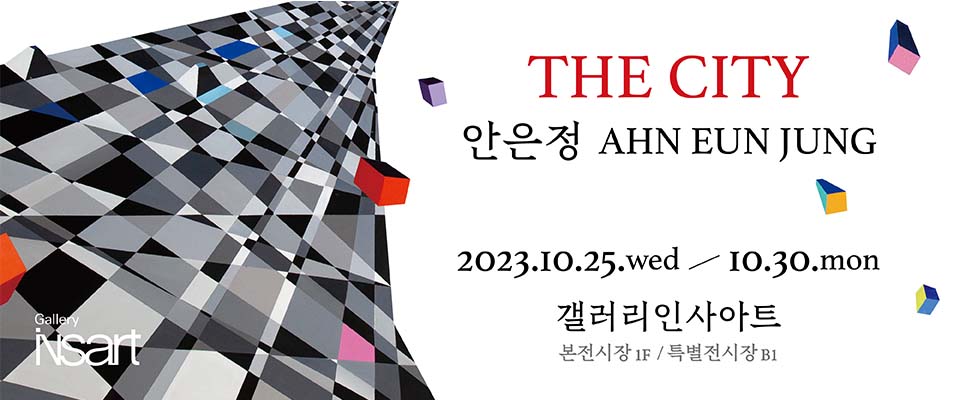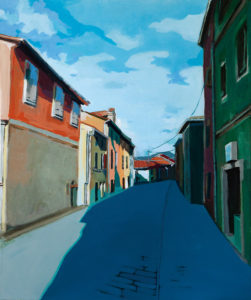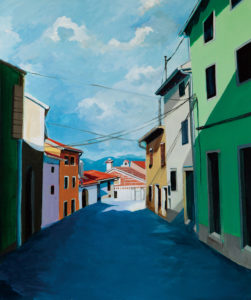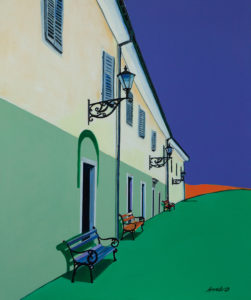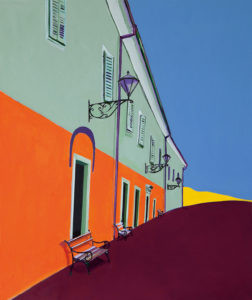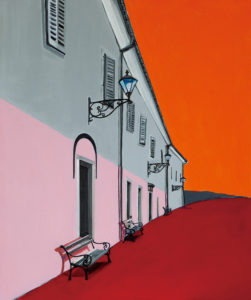안은정 개인전 THE CITY
안은정
2023 10/25 – 10/30
본 전시장 (1F) 특별 전시장 (B1)
도시의 생명성을 표현
장준석(미술평론가)
현대 문명의 거대한 도시는 아름답고 화려하며, 마음의 고향을 상실한 현대인들에게 삶을 의욕적으로 살아가게 하는 동력원이기도 하다. 그러나 오늘날의 도시는 다양하면서도 빠르게 변화하는 예측불허의 상황 속에서 현실뿐만 아니라 미래에 대한 막연한 두려움의 대상이기도 하며, 그 속을 자세히 들여다보면 수많은 사람의 호락호락하지 않은 삶의 이야기들로 애잔하다. 그뿐만 아니라 한편으로는 비인간적이며, 생존하기 위한 투쟁과 질투로 점철된 장소이기에 오히려 감각적인 아름다움의 표현을 제약하기도 한다.
작가 안은정의 작품은 주로 도시를 소재로 한 것으로, 도시 속의 사람들을 그리지는 않지만 도시가 지닌 다양한 세계와 교감이 이루어진다. 이러한 작업은 도시를 그리기보다는 도시를 통해 인간의 삶과 죽음 그리고 고뇌와 고통, 생존의 치열함, 희비의 엇갈림 등을 무언의 메시지처럼 화면 안에 담아내는 것이며, 우리가 지금까지 경험하지 못했던 새로운 이미지로 조형화하는 것이다. 작가는 체코 여행에서 아름다운 도시의 모습을 보았는데, 얼마 후에 그 자리를 떠난 후로 다른 누군가가 그 자리에서 자신이 봤던 그 모습을 다른 생각과 다른 느낌으로 바라볼 수 있음을 상상하게 되었다. 시간의 흐름 속에 있는 도시를 통해 진실한 참 세계를 생각하게 되었으며, 삶은 마치 신기루처럼 일시적일 뿐 영원할 수 없다는 것을 깨닫게 되었다. 작가는 도시의 외적인 현실보다는 내재적인 실재를 존중하며 회색의 도시 속에서 더 인간적인 것을 순수하게 표현하려 노력해왔다. 도시의 시공간 속에 공존하는 진실한 실체를 진지하게 모색하면서 오늘을 사는 현대인의 삶과 사회 빈곤층의 삶 등 다양한 실체들을 예술로 승화시켰다. 도시와 관련한 심도 있는 사색 및 미적 가치와 더불어 다양한 도시의 모습을 조형적으로 표현하면서 우리 시대의 고독한 현대인들에게 위로와 희망을 주고자 한다.
작가는 이처럼 도시 속의 실체를 예리하게 직시하고 이를 조형화하려고 노력을 해왔다. 현대 문명을 압축한 도시를 표현하기 위해 화면을 입체적으로 나누었으며, 여기에 더 작은 면들을 구성하거나 불균형의 큰 면에 원색 계열의 강도 있는 색을 구사하여 거대한 도시의 모습을 이미지화하였다. 희망과 위로, 아름다운 도시의 이미지, 화려하면서도 진정성이 스며있는 선명한 색과 명료한 직선 등이 절묘하게 결합하여 조화를 이룬다. 특히 도시를 구성하는 다양하면서도 강렬한 색은 기하학적인 도시 이미지의 구성과 하나가 되며 아름다운 통일성을 구축한다. 사람들에 의해 건설된 도시는 사람들의 꿈과 욕망이 담긴 결정체라 할 수 있을 것이다. 자연 친화적인 시골이 아닌, 욕망이 내재한 도시의 모습을 조형화하기는 쉽지 않다. 이처럼 작가의 작업은 사람에 의해 구축된 거대한 회색 도시에 새로운 희망과 생명력을 불어넣는 독특한 것이다.
작가 안은정의 작품에는 이처럼 균형감과 통일성이 내재한다. 작가는 다양함이 공존하는 도시를 캔버스에 담아내기 위하여 일정한 형태를 지양하고 도시의 이미지를 그리되, 변형적이면서도 기하학적인 특성들을 활용하여 다양한 이미지를 펼쳐 보이면서도 통일감을 구축하는 독특한 작업을 펼친다. 그래서 작품은 독특한 예술적인 가치와 의미를 지니며, 예술론적인 혹은 미학적인 분석 이전에 세련되고 기교가 뛰어나고 숙련되어 시지각적인 즐거움을 준다. 이러한 시지각적인 즐거움은 어두운 밑 색에서부터의 선명하고도 강렬한 색채와 기하학적이면서도 변칙적인 선과 특이한 공간 구성 등을 통해 펼쳐지는 창의성, 독창성, 실험성, 현대적 감각의 예술성, 수준 높은 기교 등이 한데 어우러져 형성된 것이다. 이는 현대적 감성과 우리 고유의 조형적 사고와 감흥, 문화적 이질성과 동질성 등이 교묘하게 조화를 이루는 다원주의적 하모니즘(Pluralistic harmonism)에 의한 것이기도 하다. 작가의 작품에 내재한 이러한 조형성은 예술적인 끼와 감성뿐만 아니라 새로운 조형에 대한 끊임없는 갈망과 열정적 노력에 의한 것으로 보인다.
작가의 창작은 주지하다시피 주로 회색의 도시와 연관된 삶과 예술에서의 실체적 조형성에 대한 고민이며, 이를 토대로 사람과 도시, 사물의 본질을 예술적으로 구현하고자 하는 것이다. 작가는 도시의 이미지를 기하학적으로 새롭게 조합하고 구성함으로써 조형 영역의 새로운 개척과 도시 미학 및 정신성 구현 등에 관심을 쏟아 독특한 도시 조형예술의 장르를 풍요롭게 하였다. 이러한 작품들은 도시 조형이라는 한국 현대 미술의 새로운 영역의 개척과 정체성의 구현이라는 측면에서 의의가 있으며, 날이 갈수록 회색의 이미지로 변해가는 숨 막히는 현대 도시 사회의 갈증을 덜어주는 청량제 같은 역할을 한다. 게오르크 루카치는 현대미술에 있어서 새로운 형식을 찾고자 한 수많은 시도가 비인간화적이며 이슈를 담은 실험에 그쳤다고 푸념하기도 하였는데, 작가 안은정의 작품에서는 이러한 루카치의 푸념을 넘어선 미적 생명력이 꿈틀거린다. 그러기에 중후하면서도 잘 구성된 형태미 속에서 드러나는 깊이감과 안정감은 미술을 잘 모르는 일반인들도 충분히 감지할 수 있을 만하다.
화면 속의, 파편 같은 조각조각의 기하학적 형상과 선명하면서도 아름다운 색채는 회색 도시 속의 인간성 회복을 지향하는 호소인 듯하다. 발터 벤야민(W. Benjamin)은 “무정형의 파편만큼 예술의 상징과 조형적 상징 그리고 유기적·총체적 형상과 격렬하게 대비를 이루는 것은 없다.”라고 현대 예술의 양상을 예견했는데, 새로운 조형성을 추구하는 알레고리를 통해 유기적·총체적 이미지로 격렬하게 혹은 파편적으로 평면 안에 형성된 작가의 작품 속에서 후기 모더니즘적인 요소들을 확인할 수 있다.
Expression of City’s Vitality
Jang Junseok, Art Critic
The huge cities of modern civilization are beautiful and colorful, and at the same time, they are also a source of motivation for modern people who have lost their spiritual home to live their lives with motivation. On the other hand, today’s cities are a source of vague fears not only about reality but also about the future in a diverse, rapidly changing and unpredictable situation. A detailed observation of the city’s interior evokes sadness through the stories of countless people’s difficult lives. The city is also inhumane and a place filled with struggle for survival and jealousy, so the expression of sensuous beauty may be restricted.
The main subject of Artist Ahn Eunjeong’s work is the city. Although people in the city do not appear in her works, she communicates with the diverse world of the city. In other words, rather than painting a city, she captures human life and death, agony and pain, the intensity of survival, and the joys and sorrows of humans through the city, like a silent message, and molds them into new images that we have never experienced before. She came to imagine that someone else might later see the beautiful city she encountered on her trip to the Czech Republic with different thoughts and feelings. She came to think about the true world through the city in the flow of time, and realized that life is temporary, like a mirage, and cannot last forever. The artist has tried to express more purely human things in the gray city, respecting the inner reality rather than the external reality of the city. She seriously explored the true realities that coexist in the city’s time and space, sublimating various realities such as the lives of today’s modern people and the poor in society into art. She seeks to provide comfort and hope to the lonely modern people of our time by figuratively expressing various aspects of the city along with in-depth contemplative and aesthetic values related to the city.
The artist, in this way, has keenly looked at the reality of the city and has tried to formulate it. She divided the screen three-dimensionally to express a city in which modern civilization is compressed, and imaged the appearance of a huge city through the composition of smaller surfaces or the strong use of primary colors on an unbalanced large surface. The exquisite combination of hope and comfort, images of a beautiful city, vivid colors that are gorgeous yet imbued with sincerity, and clear straight lines are in perfect harmony. In particular, the diverse yet intense colors that make up the city become one with the geometric composition of the city image, completing a beautiful unity. The city built by people is the culmination of their dreams and desires. It is not easy to model the appearance of a city with inherent desires, unlike the nature-friendly countryside. In this way, her work is unique in that it breathes new hope and vitality into the huge gray city built by people.
Artist Ahn Eunjeong’s work has a sense of balance and unity. She carries out special work to capture a city where diversity coexists on canvas, where a certain form is avoided and the image of the city is drawn, but a sense of unity is created while unfolding various images by utilizing transformative and geometric characteristics. Therefore, her works have unique artistic value and meaning, and, before artistic or aesthetic analysis, are refined, skillful, and skilled, giving visuoperceptual pleasure. This visuoperceptual pleasure is formed by the combination of creativity, originality, experimentation, modern artistry, and high-level technique unfolding through vivid and intense colors from dark undertones, geometric yet irregular lines, and unusual spatial composition. This is also due to pluralistic harmonism that cleverly harmonizes modern sensibility, our own formative thinking and inspiration, and cultural heterogeneity and homogeneity. This formativeness inherent in the artist’s work appears to be due not only to his artistic talent and sensibility, but also to his constant desire and passionate effort for new formativeness.
As mentioned earlier, the artist’s creation is mainly concerned with the tangible formativeness of life and art related to the gray city, and based on this, she artistically embodies the essence of people, cities, and objects. The artist, who was interested in pioneering new areas of formative art and realizing urban aesthetics and spirituality, enriched the unique genre of urban formative art by newly combining and composing urban images geometrically. These works are significant in terms of pioneering a new area of Korean contemporary art called urban formative art and realizing its identity and act like a refreshing drink that relieves the thirst caused by the suffocating modern urban society that is turning into a gray image day by day. Gyorgy Lukacs lamented that numerous attempts to find new forms in modern art were dehumanizing and ended up being issue-laden experiments. Ahn Eunjeong’s work shows an aesthetic vitality that goes beyond Lukacs’ complaints. Therefore, the sense of depth and stability in the profound yet well-constructed beauty of form is clearly revealed in a way that even ordinary people outside of art can perceive.
The geometric shapes and vivid yet beautiful colors of the fragment-like pieces in the picture seem to be a call for the restoration of humanity in the gray city. Walter Benjamin predicted the pattern of modern art when he said, “Nothing contrasts more violently with the symbols and plastic symbols of art and with organic and total forms than amorphous fragments.” Through allegory, which pursues new formativeness, we can identify elements of late modernism in the artist’s works, which are violently or fragmentarily formed on a two-dimensional surface using organic and holistic images.
